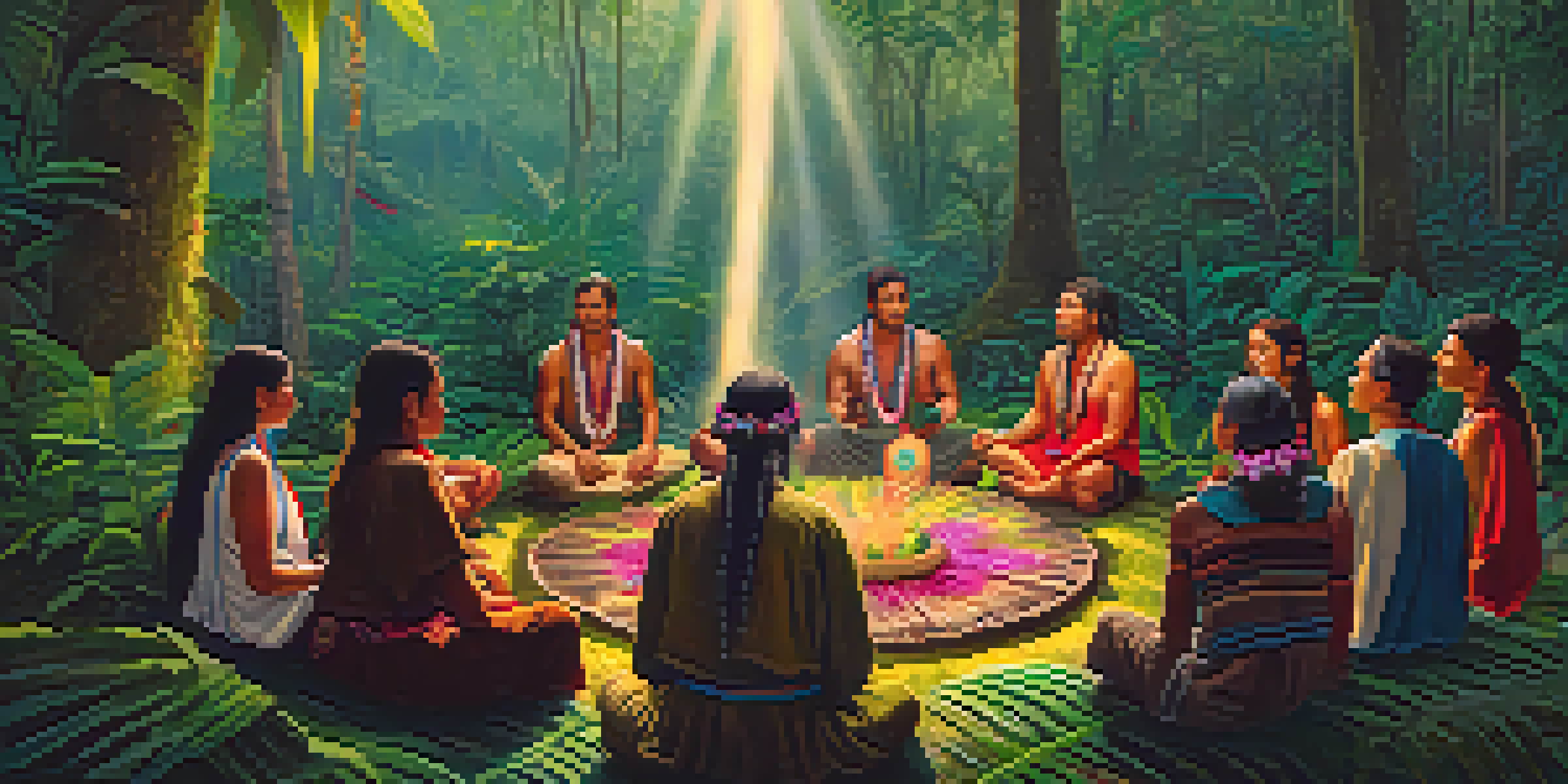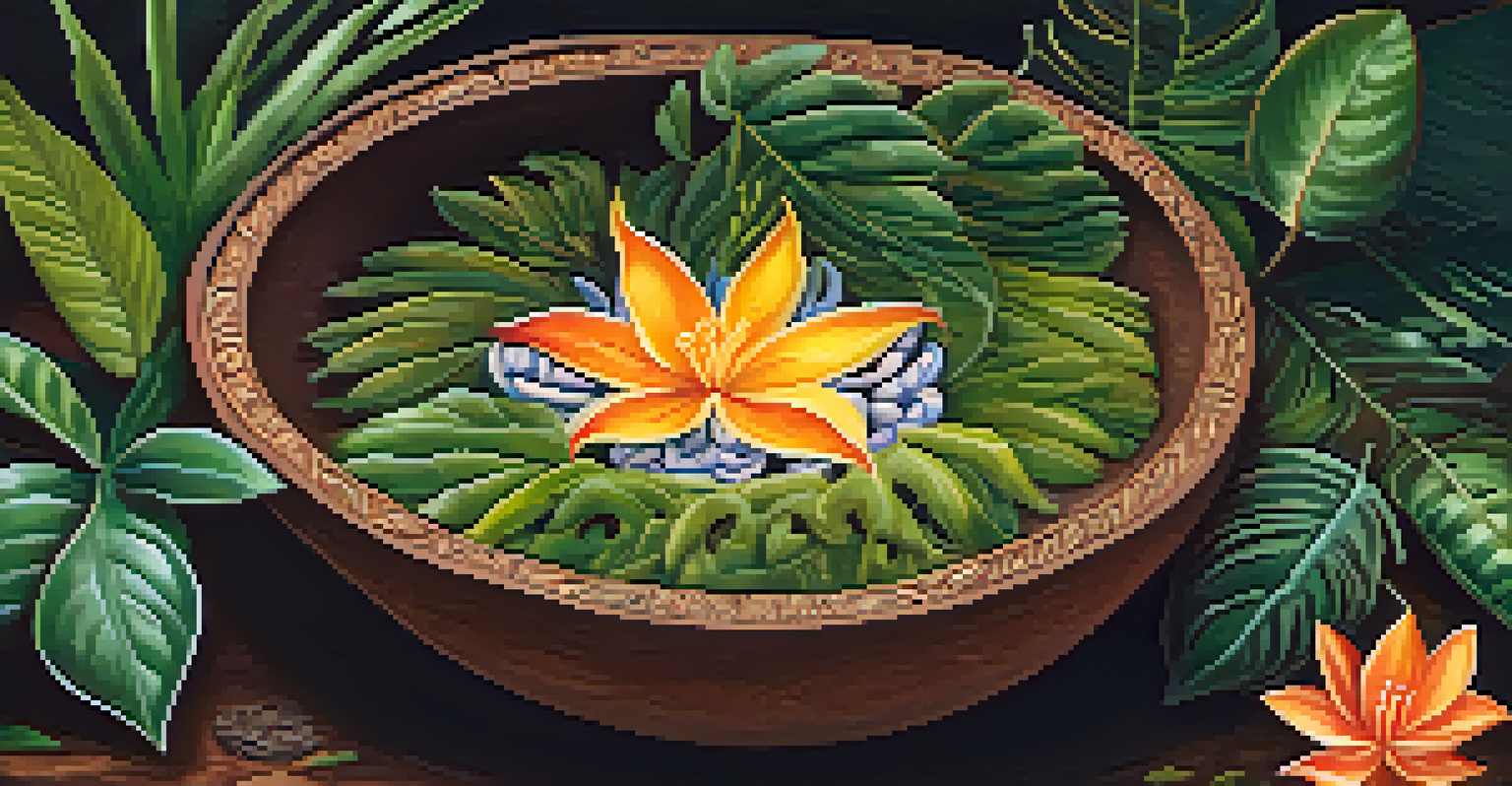Ayahuasca: A Journey Through Indigenous Spiritual Practices

What is Ayahuasca and Its Cultural Significance?
Ayahuasca is a powerful plant medicine traditionally used by Indigenous peoples of the Amazon. This brew, made from the Banisteriopsis caapi vine and other plants, is known for its psychoactive properties. For centuries, it has played a crucial role in spiritual and healing practices within communities, serving as a bridge between the physical and spiritual realms.
Ayahuasca is a journey into the self. It is a mirror reflecting the deepest corners of your soul.
In these cultures, Ayahuasca is not just a substance; it is a sacred tool for communion with the spirit world. Shamans, or healers, guide participants through their experiences, often referred to as 'journeys.' These journeys can lead to profound insights, healing, and a deeper understanding of one’s self and connection to nature.
The cultural significance of Ayahuasca extends beyond personal healing; it embodies a holistic worldview. It emphasizes the interconnectedness of life, nature, and spirituality, offering a lens through which many Indigenous people view their existence and purpose.
The Rituals Surrounding Ayahuasca Ceremonies
Ayahuasca ceremonies are rich in ritual and tradition, often held in a serene natural setting to enhance the experience. Participants typically gather in a circle, and the shaman prepares the brew with great care, often chanting or singing during the process. This preparation is not just about the physical act; it involves invoking spiritual energies to create a safe and sacred space.

During the ceremony, participants consume the Ayahuasca brew, often under the guidance of the shaman. The experience can last several hours and may involve intense emotional and physical responses. Participants may undergo visions or deep introspection, leading to personal revelations and emotional releases.
Ayahuasca's Cultural Importance
Ayahuasca serves as a sacred tool for Indigenous peoples, facilitating spiritual healing and a deeper connection to nature.
Post-ceremony discussions are also an integral part of the process. Sharing experiences helps individuals process their journeys and can foster a sense of community and support among participants. This communal aspect emphasizes the importance of connection, both with oneself and others.
Benefits of Ayahuasca: Healing and Self-Discovery
Many people report transformative benefits after participating in Ayahuasca ceremonies. Common themes include emotional healing from trauma, increased self-awareness, and a profound sense of peace. These outcomes are often attributed to the introspective nature of the experience, which allows individuals to confront their fears and unresolved issues.
The medicine of the Amazon is not just about healing; it’s about understanding the interconnectedness of all life.
Scientific studies have begun to explore Ayahuasca's potential benefits, particularly in treating mental health conditions like depression and anxiety. Some research suggests that the brew may promote neuroplasticity, the brain’s ability to adapt and change, which can be pivotal in the healing process.
However, it’s essential to approach Ayahuasca with respect and caution. While many have found healing, not everyone has a positive experience. It’s crucial to seek out reputable facilitators and be aware of the psychological and physical risks involved.
Understanding the Role of the Shaman
In Ayahuasca ceremonies, the shaman plays a vital role as a guide and protector. With extensive training in traditional healing practices, shamans have a deep understanding of the plants and their effects. Their expertise ensures that the experience is as safe and beneficial as possible for participants.
Beyond just administering the brew, shamans use music, chants, and rituals to help navigate the journey. These elements are believed to carry spiritual energy, creating an environment conducive to healing and exploration. The shaman’s presence helps to ground participants, providing reassurance during intense emotional or psychological experiences.
Role of the Shaman in Ceremonies
Shamans guide participants through Ayahuasca experiences, using their knowledge and rituals to ensure safety and support.
The relationship between the shaman and participants often extends beyond the ceremony, fostering a sense of trust and community. This connection can be incredibly important for individuals seeking healing or guidance, emphasizing the communal aspect of Indigenous practices.
Cultural Appropriation vs. Respectful Engagement
As Ayahuasca gains popularity outside Indigenous communities, discussions about cultural appropriation have emerged. It’s crucial to recognize that this sacred practice is rooted in specific cultural contexts and should not be commodified. Engaging with Ayahuasca requires a genuine respect for its origins and the traditions surrounding it.
Respectful engagement involves understanding the cultural significance of Ayahuasca and approaching it with humility. This means prioritizing Indigenous voices, seeking guidance from knowledgeable practitioners, and supporting the communities that have preserved these traditions for generations.
By fostering respectful relationships with Indigenous peoples, individuals can enjoy the benefits of Ayahuasca while honoring its cultural heritage. This approach not only enhances the experience but also contributes to the sustainability of the practices and communities involved.
The Science Behind Ayahuasca Experiences
Research into Ayahuasca is still in its infancy, but initial studies have provided intriguing insights into how it works. The brew contains DMT (dimethyltryptamine), a compound that induces vivid hallucinations and altered states of consciousness. When ingested, DMT interacts with serotonin receptors in the brain, leading to its profound psychological effects.
Additionally, the MAOI (monoamine oxidase inhibitor) properties of the Banisteriopsis caapi vine allow DMT to be orally active, setting Ayahuasca apart from other psychedelic substances. This unique combination creates an experience unlike any other, often described as both challenging and enlightening.
Navigating Post-Ayahuasca Insights
The integration period following Ayahuasca ceremonies is crucial for processing insights and fostering personal growth.
While the science is still emerging, anecdotal reports and preliminary studies suggest that Ayahuasca may have therapeutic potential, particularly for conditions like PTSD or depression. However, more rigorous research is needed to fully understand its effects and implications for mental health treatment.
Navigating the Aftermath of Ayahuasca Journeys
Experiences with Ayahuasca can be intense, and the aftermath often requires careful navigation. Participants may find themselves reflecting on their journeys for days or even weeks afterward, processing emotions and insights that emerged during the ceremony. This period of integration is crucial for translating the experience into meaningful changes in daily life.
Many find it helpful to engage in practices such as journaling, meditation, or therapy to support this integration process. Sharing experiences with trusted friends or community members can also offer valuable perspectives and support, helping individuals make sense of what they encountered.

Ultimately, the journey doesn’t end with the ceremony. The insights gained can lead to ongoing growth and transformation, encouraging participants to live more authentically and in tune with their values and purpose.